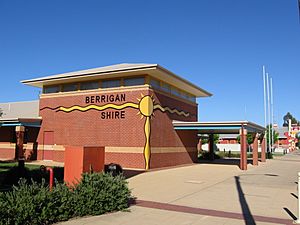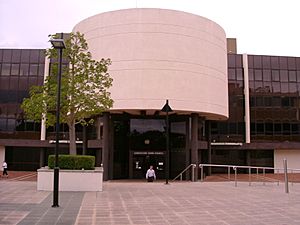Local government in Australia facts for kids
Local government in Australia is like the third level of government in the country. It works under the states and territories, which are below the main federal government. Think of it as a team working closest to you in your local area!
The Australian Constitution, which is the rulebook for how Australia is governed, doesn't actually mention local government. There have been two attempts in the past (in the 1970s and 1980s) to change the Constitution to include local government, but these attempts weren't successful. However, every state government in Australia does have local government mentioned in their own state rulebooks.
Unlike countries like Canada or the United States, Australia has only one main type of local government in each state. There aren't different levels like "cities" and "counties" that do different things.
The group that runs local government is usually called a "council." The areas they look after are called "local government areas" (LGAs). Sometimes, you might hear them called "cities" or "shires," which also describe the type of area they cover. In August 2016, there were 547 local councils across Australia.
Even though there are many local councils, some very large areas with few people don't have their own local government. In these places, special groups or the state government itself might handle local services. Local councils in Australia can be tiny, like the Shire of Peppermint Grove in Perth, which is only about 1.5 square kilometres. Or they can be huge, like the Shire of East Pilbara in Western Australia, which is bigger than countries like Germany or Japan!
Contents
How States Control Local Government
Local governments exist because the states and territories allow them to. This means that how councils work can be a little different in each state or territory. But they all have similar jobs.
Here are the lists of local government areas for each state and territory:
- Local government areas of New South Wales
- Local government areas of the Northern Territory
- Local government in Queensland (List)
- Local government areas of South Australia
- Local government areas of Tasmania
- Local government areas of Western Australia
- Local government areas of Victoria
The other territories in Australia don't have separate local governments. State government departments keep an eye on local councils. They can step in if needed, but they must follow the laws.
A Quick Look at Local Government Types
The Australian Classification of Local Governments (ACLG) helps sort Australian local councils. It uses things like how many people live there, how crowded it is, and how much of the population lives in cities. This helps understand the different kinds of areas councils manage.
The main types are:
- RA – Rural Agricultural (farming areas)
- RS – Rural Significant (important rural areas)
- RT – Rural Remote (far-away rural areas)
- UC – Urban Capital (capital city areas)
- UD – Urban Developed (developed city areas)
- UF – Urban Fringe (areas on the edge of cities)
- UR – Urban Regional (regional city areas)
A Brief History of Local Government
Even though the main Australian Constitution doesn't mention local government, it does appear in notes about the Constitution. It talks about "Municipal institutions and local government" as a power of the colonies (which became states).
The very first official local government in Australia was the Perth Town Trust, started in 1838. The Adelaide Corporation followed in 1840. Then came the City of Melbourne and the Sydney Corporation in 1842. These early attempts didn't last long. It wasn't until the 1860s and 1870s that stable local governments became common. Their main job back then was to raise money for building roads, especially in country areas.
Before Australia became a federation of states, local government was seen as outside the main government's responsibilities. In the 1970s, the Whitlam Government started giving more money to local governments, not just for roads, but for other general purposes too.
Changes Over Time
Big changes happened in the 1980s and 1990s. State governments started looking at how local councils could work more efficiently, like businesses do. Many states looked into joining smaller councils together. For example, in the early 1990s, Victoria reduced its number of local councils from 210 to just 78!
Other states like South Australia, Tasmania, and Queensland also saw some councils merge. Western Australia and New South Wales at first said no to forced mergers, but New South Wales later made some councils join. The main idea behind merging councils was to make them more efficient. However, some people felt that forcing councils to merge meant less local say for people.
After mergers, councils offered more services, but they only saved a little bit of money (less than 10%). Many people lost their jobs, and some who stayed had more work to do.
Another change has been the growth of Regional Organisations of Councils (ROCs). These are groups where several councils work together on bigger projects. In 1995, there were 50 such groups, and by 2002, there were 55.
Different Types of Local Councils

Local governments are smaller parts of the states and the Northern Territory. The Australian Capital Territory (where Canberra is) doesn't have separate local governments. The territory government there does the jobs that both state and local governments would normally do.
Even though they all do pretty much the same things, Australian local councils have different names. The general term is "local government area," but the council itself is usually just called a "council." Today, you might see names like "borough," "city," "district," "municipality," "region," "shire," "town," "community government," "Aboriginal shire," and "Island." Some areas just use "Council" in their name.
Usually, a local government area in a city or suburb is called a city, like the City of Canada Bay. It's run by a City Council. A country area covering a larger rural space is usually called a shire, like the Shire of Mornington Peninsula. It's run by a Shire Council.
Sometimes, other words are used. "Municipality" is used for some older city areas in New South Wales and some country towns in South Australia. Some rural areas in South Australia are called "District Councils." Larger country towns and smaller city centres in Queensland and Western Australia might just use "Town." New South Wales and Queensland have also started using "Region" for bigger councils formed by joining smaller shires or country cities. The word "Borough" used to be common in Victoria, but now only the Borough of Queenscliffe remains.
Most local councils have similar jobs and structures, no matter what they are called. They usually have an elected council and a mayor or shire president who leads the meetings. Sometimes, the mayor is chosen directly by the people, but most often, the councillors choose the mayor from among themselves. The mayor's powers can also vary. In some states, like Queensland, mayors have a lot of power. In New South Wales, mayors are mostly there for ceremonies and only have power if the council allows it.
Most capital city councils only manage the main city centre and nearby suburbs. A big exception is the City of Brisbane, which is the largest council in Australia and manages a large part of the Brisbane city area. When you hear about a city's population, it often means the population of the whole statistical area, not just the local government area.
Local Government and the Constitution
State governments decide what powers local governments have. States are also mainly responsible for funding and overseeing local councils.
As mentioned, local government is noted in the annotated Australian Constitution as a part of the State Governments. It's also in the constitution of each of the six states. In 1988, there was a vote (a referendum) to put local government directly into the federal constitution, but it didn't pass. Another vote was planned for 2013 but was cancelled.
The federal government often works with local councils by giving them money (grants) to help pay for projects managed by local government.
What Local Councils Do

All local councils have similar powers, but councils in big cities like Brisbane or the Gold Coast have more money because they have more people. Unlike local governments in many other countries, services like police, fire protection, and schools are handled by the state or territory government, not by local councils.
In the first half of the 1900s, councils mainly built roads, bridges, and sewerage systems. From the 1970s, their focus changed to community facilities like libraries and parks. They also started looking after local roads, town planning, approving new buildings, and local services like waste disposal. Child care, tourism, and improving city areas also became part of their job. Councils pay for these services by collecting local land taxes, called "rates," and by getting money from state and federal governments. People sometimes joke that councils only care about the "three Rs": Rates, Roads, and Rubbish!
However, local councils in Australia have taken on more roles recently. Higher levels of government have given them more tasks. For example, they now help with community health services, regional airports, pollution control, community safety, and making transport easier to use. This change is like moving from looking after "things" to looking after "people." People expect more from local government now, partly because they are more involved in decisions and want clearer ways of working.
In recent years, some state governments have given councils even more powers. In Queensland and Western Australia, councils can now make their own local laws, instead of just following older rules. Councils have also set up their own groups, like Local Government Associations and Regional Organisations of Councils, to work together.
New ideas about how public services should be run have led to state governments giving local councils more freedom. This helps councils be more flexible in how they work.

